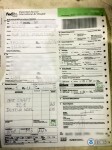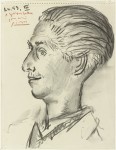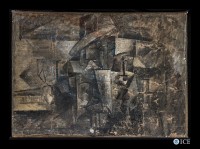 A package described on the shipping label as an “art craft” worth 30 euros ($37) turns out to have been a stolen Picasso worth $15 million. The package was sent to the US from Belgium last December and was opened by customs agents at the Port of Newark who were acting on a lead. The sender’s name was listed only as “Robert” and the destination address was a climate-controlled warehouse in Queens. Because the statements on the label and the commercial invoice describing it as an “art craft/toy” were false, the painting was seized. Authorities have made no comment on any current investigation of the theft and attempted smuggling, who the “Robert” in Belgium might be, who the recipient in the United States was meant to be.
A package described on the shipping label as an “art craft” worth 30 euros ($37) turns out to have been a stolen Picasso worth $15 million. The package was sent to the US from Belgium last December and was opened by customs agents at the Port of Newark who were acting on a lead. The sender’s name was listed only as “Robert” and the destination address was a climate-controlled warehouse in Queens. Because the statements on the label and the commercial invoice describing it as an “art craft/toy” were false, the painting was seized. Authorities have made no comment on any current investigation of the theft and attempted smuggling, who the “Robert” in Belgium might be, who the recipient in the United States was meant to be.
 On January 30th, experts authenticated the work as La Coiffeusse (The Hairdresser), an early cubist piece painted by Picasso in 1911. It was once owned by art historian and hero of two world wars Georges Salles who bequeathed it to the National Museums of France after his death in 1966. Salles’ mother was Claire Eiffel, daughter of engineer Gustave Eiffel of tower fame, so from a young age he was traveled in high cultural circles. He studied literature and law and school and immersed himself in the rich artistic world of pre-war Paris. He fought for France in World War I and was awarded the Croix de Guerre twice. After the war he become the Louvre’s curator of Asian Art. He was the director of the Guimet Museum in Paris when World War II broke out. Again he fought for his country, this time in the French Resistance, and was instrumental in keeping the irreplaceable artistic patrimony of France’s museums out of Nazi hands. His efforts won him yet another Croix de Guerre.
On January 30th, experts authenticated the work as La Coiffeusse (The Hairdresser), an early cubist piece painted by Picasso in 1911. It was once owned by art historian and hero of two world wars Georges Salles who bequeathed it to the National Museums of France after his death in 1966. Salles’ mother was Claire Eiffel, daughter of engineer Gustave Eiffel of tower fame, so from a young age he was traveled in high cultural circles. He studied literature and law and school and immersed himself in the rich artistic world of pre-war Paris. He fought for France in World War I and was awarded the Croix de Guerre twice. After the war he become the Louvre’s curator of Asian Art. He was the director of the Guimet Museum in Paris when World War II broke out. Again he fought for his country, this time in the French Resistance, and was instrumental in keeping the irreplaceable artistic patrimony of France’s museums out of Nazi hands. His efforts won him yet another Croix de Guerre.
 Salles was a close friend of Picasso’s. There are four drawings of Salles by Picasso in the National Museums bequest, and it was Salles who persuaded Picasso to directly donate several major works to the National Museums. After Salles’ death, his Picassos were assigned to the Musée National d’Art Moderne in the Georges Pompidou Center in Paris, among them La Coiffeusse. The painting was not on display when it disappeared. The last time it was exhibited was at the Kunsthalle Munich in 1998 after which it returned to the Pompidou Center where it was kept in storage. Only when another institution inquired about a possible loan of the piece in 2001 did museum personnel realize that it was gone. The museum reported the theft to the police in November, 2001, and the work has been listed on Interpol’s Stolen Works of Art database since then.
Salles was a close friend of Picasso’s. There are four drawings of Salles by Picasso in the National Museums bequest, and it was Salles who persuaded Picasso to directly donate several major works to the National Museums. After Salles’ death, his Picassos were assigned to the Musée National d’Art Moderne in the Georges Pompidou Center in Paris, among them La Coiffeusse. The painting was not on display when it disappeared. The last time it was exhibited was at the Kunsthalle Munich in 1998 after which it returned to the Pompidou Center where it was kept in storage. Only when another institution inquired about a possible loan of the piece in 2001 did museum personnel realize that it was gone. The museum reported the theft to the police in November, 2001, and the work has been listed on Interpol’s Stolen Works of Art database since then.
Once the authenticity of the painting and was confirmed, Loretta Lynch, then US Attorney for the Eastern District of New York and now Attorney General, filed a civil forfeiture complaint which allows the government to gain legal title to a forfeited good and, in this case, to return it to its rightful owner. Immigration and Customs Enforcement (ICE) Director Sarah R. Saldaña officially handed over the painting to Frédéric Doré, Deputy Chief of Mission of France at a ceremony at the French Embassy in Washington, D.C., on August 13th.
While the museum is keen to kill the fatted calf and display its prodigal daughter as soon as she gets home, La Coiffeusse is going to need some recovery time. In the (at least) 14 years since the theft, the painting has significantly deteriorated. Apparently the thieves and whoever else has put their hands on it over the course of a decade and a half treated it like the 30 euro handicraft they claimed it was. It will require extensive conservation before it can be exhibited.